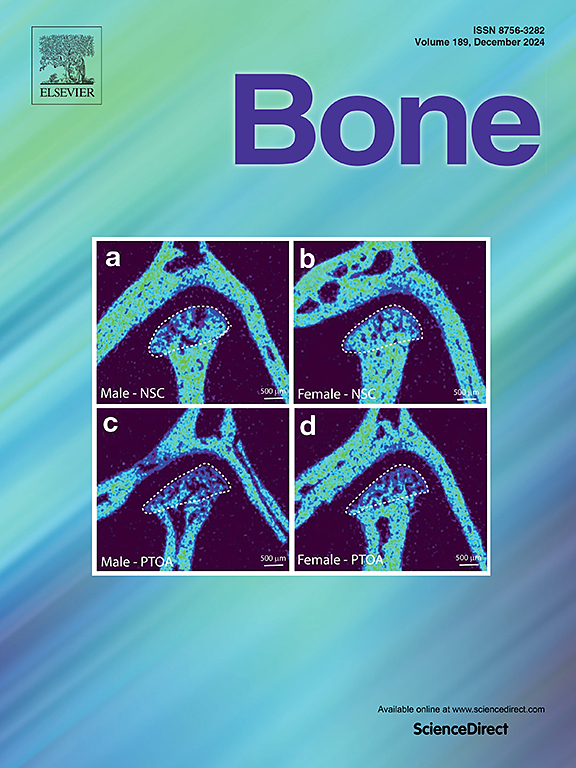Role and mechanism of Actein on condylar bone metabolism in APOE deletion-induced osteoporotic mice
IF 3.5
2区 医学
Q2 ENDOCRINOLOGY & METABOLISM
引用次数: 0
Abstract
Aims
To investigate the effects of Actein from Cimicifugae Rhizoma on condylar bone and cartilage in APOE deletion-induced osteoporotic mice, and to preliminarily explore the underlying mechanism.
Methods
Sixty 8-week-old female mice were used, which underwent APOE−/− and ovariectomy procedures, followed by oral administration of Actein (15 mg/kg) and Atorvastatin Calcium (AC, 3 mg/kg) for eight weeks. Body weight, uterine weight, and systemic indexes related to bone metabolism and lipid metabolism were assessed in each group. Changes in condylar bone histomorphometric parameters were evaluated using Micro-CT. Morphological changes in the condyle were observed with Hematoxylin-Eosin (H&E), Safranin O/Fast Green, and Alcian Blue Hematoxylin/Orange G (ABH/OG) staining, with OARSI pathology scoring performed. Sirius red staining and immunofluorescence were used to determine the expression levels of Collagen I (Col I) and Collagen III (Col III) in bone matrix, and Col II in cartilage matrix. Immunohistochemistry assessed the relative expression levels of ALP and proteins associated with the Wnt/β-catenin/RUNX2 signaling pathway.
Results
APOE−/− exacerbates ovariectomy -induced osteoporosis (OP) in condylar of mice. Actein and AC significantly reversed OP, improved bone mineral density (BMD), increased bone microarchitecture, and restored abnormal calcium and phosphorus metabolism in the blood and urine. Morphologically, APOE−/− and ovariectomy reduced condylar cartilage thickness, disrupted chondrocyte arrangement, chondrocyte cleavage, and clustered aggregation, resembling osteoarthritis (OA)-like changes. Actein and AC partially restored the disrupted chondrocyte arrangement, smoothed chondrocyte cleavage, and up-regulated the levels of chondrocyte matrix (Col II, aggrecan) and bone matrix (Col III, ALP). Actein reversed the OA process, potentially through the Wnt/β-catenin/RUNX2 signaling pathway.
Conclusion
APOE−/− and ovariectomy induced OP, leading to OA-like lesions in condylar of mice. Actein promoted cartilage repair and trabecular bone recovery by increasing extracellular matrix synthesis (Col II, Col III, aggrecan), reversing the OA process, possibly through the Wnt/β-catenin/RUNX2 signaling pathway.
放线菌素对 APOE 缺失诱导的骨质疏松小鼠髁骨代谢的作用和机制
目的:研究慈姑根中的放线菌素对APOE缺失诱导的骨质疏松小鼠髁突骨和软骨的影响,并初步探讨其潜在机制:采用 60 只 8 周龄雌性小鼠,对其进行 APOE-/- 和卵巢切除术,然后口服阿克替因(15 毫克/千克)和阿托伐他汀钙(AC,3 毫克/千克)八周。对各组的体重、子宫重量以及与骨代谢和脂质代谢相关的系统指标进行了评估。使用显微 CT 评估了髁状突骨骼组织形态参数的变化。用苏木精-伊红(H&E)、赛庚啶O/快绿和阿尔新蓝苏木精/橙G(ABH/OG)染色观察髁骨的形态变化,并进行OARSI病理学评分。天狼星红染色和免疫荧光用于确定骨基质中胶原 I(Col I)和胶原 III(Col III)以及软骨基质中胶原 II 的表达水平。免疫组化评估了ALP和与Wnt/β-catenin/RUNX2信号通路相关的蛋白质的相对表达水平:结果:APOE-/-加剧了卵巢切除术诱导的小鼠髁状突骨质疏松症(OP)。放线菌素和 AC 能明显逆转髁状突骨质疏松症,改善骨矿物质密度(BMD),增加骨的微结构,并恢复血液和尿液中异常的钙磷代谢。从形态学上看,APOE-/-和卵巢切除降低了髁软骨厚度,破坏了软骨细胞排列、软骨细胞裂解和聚集,类似于骨关节炎(OA)的变化。放线菌素和 AC 部分恢复了被破坏的软骨细胞排列,平滑了软骨细胞裂解,并上调了软骨细胞基质(Col II,凝集素)和骨基质(Col III,ALP)的水平。放线菌素可能通过Wnt/β-catenin/RUNX2信号通路逆转了OA过程:结论:APOE-/-和卵巢切除诱发OP,导致小鼠髁突出现类似OA的病变。Actein可通过增加细胞外基质(Col II、Col III、 aggrecan)的合成促进软骨修复和骨小梁的恢复,从而逆转OA过程,这可能是通过Wnt/β-catenin/RUNX2信号通路实现的。
本文章由计算机程序翻译,如有差异,请以英文原文为准。
求助全文
约1分钟内获得全文
求助全文
来源期刊

Bone
医学-内分泌学与代谢
CiteScore
8.90
自引率
4.90%
发文量
264
审稿时长
30 days
期刊介绍:
BONE is an interdisciplinary forum for the rapid publication of original articles and reviews on basic, translational, and clinical aspects of bone and mineral metabolism. The Journal also encourages submissions related to interactions of bone with other organ systems, including cartilage, endocrine, muscle, fat, neural, vascular, gastrointestinal, hematopoietic, and immune systems. Particular attention is placed on the application of experimental studies to clinical practice.
 求助内容:
求助内容: 应助结果提醒方式:
应助结果提醒方式:


